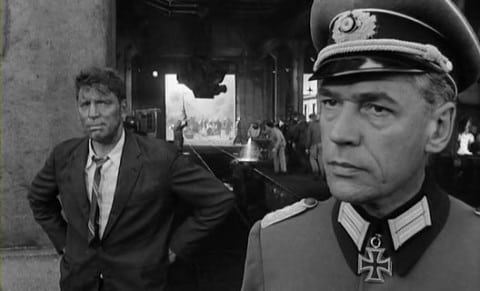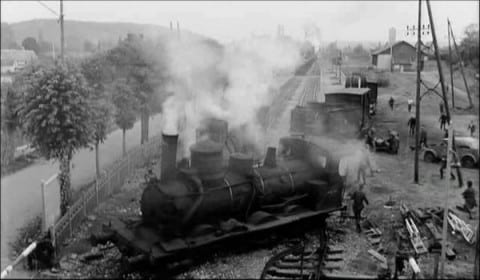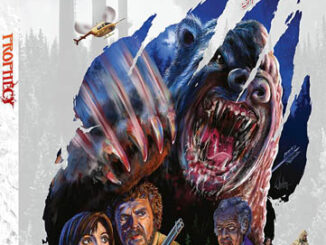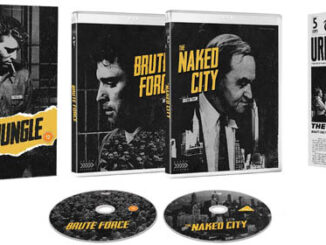The Train (1964)
Directed by: John Frankenheimer
Written by: Frank Davis, Franklin Coen, Rose Valland
Starring: Burt Lancaster, Jeanne Moreau, Paul Scofield, Suzanne Flon
USA
ON BLU-RAY: Now, from ARROW ACADEMY
RUNNING TIME: 140 min
REVIEWED BY: Dr Lenera, Official HCF Critic
In 1944, art masterpieces stolen by the Wehrmacht from French museums are being shipped to Germany. The officer in charge of the operation, Colonel Franz von Waldheim, is an ardent art lover and is determined to take the art to Germany, no matter the cost. After the Germans remove the art chosen by Waldheim from the Jeu de Paume Museum, curator Mademoiselle Villard seeks help from the French Resistance. Given the imminent liberation of Paris by the Allies, they need only delay the train for a few days, but it must be done in such a way that does not risk damaging the priceless cargo. Resistance cell leader and railway inspector Paul Labiche initially rejects the plan, refusing to “waste lives on paintings”, he has a change of heart when an elderly engineer, Papa Boule is executed for trying to sabotage the train on his own….
Definitely up there with other great train movies like Runaway Train, The General and The Taking Of Pelham 123, The Train was made during a run of fine films from its director John Frankenheimer, who went a little downhill after the 60’s but could always still be relied on to provide a solid, well crafted picture [please, somebody release The Challenge on DVD or Blu-ray!]. Watching it, it struck me how it was certainly one kind of film that would probably be done so differently nowadays that it would seem almost an entirely different picture. The real trains [no models were used whatsoever] and stunts would be nearly all CGI and the film would be shorter and faster. The Train does take a while to get where it’s going, but films like this often took more time back then, it shouldn’t necessarily be seen as a flaw. For much of its duration, The Train is a gripping, authentic-seeming picture [well, nearly everything is real in it, from the trains to its star Burt Lancaster doing every single one of his own stunts ] which has its moral questions to raise and a little bit of character complexity without bogging the film down. And it probably goes without saying that it’s far better than the recent The Monuments Men which also dealt with the true life issue of the Germans stealing precious works of art.
This was based on the factual book Le front de l’art by Rose Valland, who was a French art historian and resistance member and who actually inspired the character of Mlle Villand in the film. She documented the works of art placed in storage that had been looted by the Germans from museums and private art collections for shipment to Germany in World War 2. The real event elaborated on in the film did have paintings loaded on to a train bound for Germany, but in real life the train was merely routed onto a ring railway and circled around Paris until the Allies arrived. The film was originally intended to be a more intimate, character-based film under the direction of Arthur Penn, but star Burt Lancaster wanted a larger-scale, more action oriented picture, so production was shut down while the script was rewritten and John Frankenheimer hired to replace Penn. As a stroke of luck, the French rail industry was standardising its track gauge and allowed the filmmakers to buy and wreck as many old trains as they wanted as well as destroy a rail yard which was to be rebuilt. The budget doubled and Frankenheimer even shut down the first unit for two weeks and commenced shooting when the weather improved. Eventually United Artists demanded that principal photography be completed in seven weeks, which was achieved under great duress, though UN then felt that there wasn’t enough action and a plane attack scene was inserted into the first third of the film.
The film begins with Colonel Franz von Waldheim looking admiringly at paintings in an art gallery. We immediately identify him as the movie’s principal bad guy but he’s clearly cultured and has a great appreciation of art. This is in clear contrast to the film’s ‘hero’ Paul Labiche, who thinks it’s crazy to waste lots of time, effort and indeed lives on simply trying to stop a train filled with art going to its destination. Why not either just leave it alone or blow the whole thing up? It is this supporting story, where you know that Labiche will eventually realise that the Nazis are effectively carrying off a large piece of the heart of France, which gives the film its weight, and I kept switching opinions throughout the duration of the film as to whether some paintings where worth all this trouble. Frankenheimer and his scriptwriters Franklin Coen and Frank Davis never totally adopt one point of view. They also take their time in the first third of the film and, while I do enjoy a lengthy build-up to action, there is rather too much footage of rail operations which may very well bore some if they’re not interested in old trains and railways. It’s also difficult to get used to a film where everybody speaks English and the Germans speak it in mostly German accents and the French speak it in mostly French accents, but good old Burt, despite playing a Frenchman, doesn’t attempt any kind of accent whatsoever. He took a day off during shooting to play golf and stepped in a hole which aggravated an old knee injury. This is why Frankenheimer had his character shot in the leg, thus enabling him to limp through the rest of the shooting, though there are clearly some scenes after the ‘shooting’ where he’s not attempting a limp at all, these obviously having been shot earlier. Frankenheimer was certainly clever though – when two of the French actors couldn’t stay on due to obligations elsewhere, he had their characters shot dead by the Germans.
Once the train with the paintings gets on the move with Labiche being forced by Waldheim to drive it in case of any trouble as well as trying to ensure that the train never enters Germany, the battle of wills between Labiche and Waldheim temporarily takes a back seat, with even some humour concerning attempts to fool the Germans on the train that they are no longer in France whereas in fact they’re not very far from where they started. There’s always the danger of bombing from the Allies, with one particularly hair-raising train dash while the locomotive is being strafed by bombers [real World War 2 planes used here too] and the bombing of a rail yard executed with real dynamite [you can tell this by the shockwaves travelling through the ground], and the 50-year old Lancaster really gives Jackie Chan a run for his money as he leaps on and off trains and walls and rolls down a mountain and across a road before getting up and staggering towards the train, but it’s the mass train wrecking that is most awesome. One crash is simply amazing because they placed cameras so close to it that it looks like one train almost hits the screen. In actual fact, three cameras were wiped out for this shot but you still get an incredible miracle shot of tons of iron and metal hurling towards the screen and a spinning train wheel suspended in the air, just inches from the lens.
There are many instances of Frankenheimer’s oft-employed device of having somebody in the foreground and others in deep focus in the background, giving a strong impression of depth of field, and some terrific tracking shots, most notably when Labiche attempts to flag down a train, then slides down a ladder, runs along the tracks, and jumps onto the moving locomotive, and when Waldheim stops a convoy of retreating Germans and tries to commandeer it. He has an argument with the convoy’s officer. The camera tracks left to right, then the officer walks off into the distance for a bit, Waldheim walks in the opposite direction, and when he barks an order, the camera cranes to give us a nice tilt effect, all this being achieved with dolly tracks [so the cameras remains steady, something that may modern filmmakers don’t seem bothered about!] and with nothing going out of focus. He also stages violence with maximum impact while showing very little, like an execution where we focus on the face of Labich until we hear the gunshot, where we cut to, from quite a long distance, a man fall forward from a pillar. It gives the impression of how casual and unimportant shooting people was to the Nazis. On his day, Frankenheimer was an absolute master with almost unparalled technical skill, and I’ve always wondered why he isn’t better known.
Despite his immense physical prowess, Lancaster remains a solid ‘everyman’ hero and Scofield a ruthless, steely villain, though his accent wavers a bit. There are some fine performances from the largely French supporting cast, though you may wonder why Jeanne Moreau is in the movie, her character coming across as pointless [though at least the film stops short of providing a romance], and Maurice Jarre’s score thumps away in the background while knowing when to stop. The cinematography was done by two people, Jean Tournier and Walter Wottitz, though it’s quite seamless with its prominent used of blacks. The Train sometimes manages to overstate its points, like when twenty or thirty dead Frenchmen are visually weighed against dozens of crates marked with the names of painters, and it has a few moments that seem a bit extraneous. I could have done with far less loving train shots that almost come across as train porn, but then Frankenheimer wanted to show off all the real-life toys he had at his disposal,and who could blame him? The Train, a fine World War 2 thriller that also provides a bit of food for thought, proves that nothing is a substitute for the real thing.
Rating: 









The Train comes to Region B Blu-ray in another great transfer from Arrow, especially notable for how deep and consistent all the black looks. The special features omit one commentary which was on the Region A Twilight Time release, but retain Frankenheimer’s interesting commentary and add some interesting bits and pieces including the second part of an excellent in-depth look at Lancaster’s career, the first part of which was on the Brute Force Blu-ray, and an interesting French TV news report looking at the filming and its effect on the locals.
SPECIAL FEATURES
* High Definition Blu-ray (1080p) presentation of the film
* Uncompressed 1.0 mono PCM audio
* Optional English subtitles for the deaf and hard of hearing
* Audio commentary by director John Frankenheimer
* Optional isolated score by Maurice Jarre
* Burt Lancaster in the Sixties – a newly-filmed interview with Lancaster’s biographer Kate Buford, tracing the actor’s career throughout the decade
* French television news report on the making of The Train, containing interviews with the locals of Acquigny
* Archive interview with Michel Simon
* Footage of The Train’s gala screening in Marseilles
* Theatrical Trailer
* Reversible sleeve featuring original and newly commissioned artwork by Vladimir Zimakov
* Collector’s booklet featuring new writing on the film by Sheldon Hall, illustrated with original stills and artwork








Be the first to comment